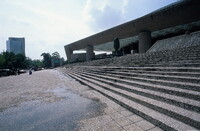| dc.coverage.spatial | Site: Mexico City, Distrito Federal, Mexico | en_US |
| dc.coverage.temporal | 1952 (creation); 1990 (alteration) | en_US |
| dc.creator | González de León, Teodoro | en_US |
| dc.creator | Zabludovsky, Abraham | en_US |
| dc.date | 1952 | en_US |
| dc.date.accessioned | 2013-01-25T21:49:49Z | |
| dc.date.available | 2013-01-25T21:49:49Z | |
| dc.date.issued | 1952 | en_US |
| dc.identifier | 186584 | en_US |
| dc.identifier.other | archrefid: 1851 | en_US |
| dc.identifier.uri | http://hdl.handle.net/1721.3/95778 | |
| dc.description | National Auditorium (Spanish: Auditorio Nacional) is one of the main concert and performance centres in Mexico City, which also was a sports venue in the past. Constructed in 1952, it was used for volleyball and basketball matches of the 1954 Central American and Caribbean Games and had seen performances of the San Francisco Ballet and New York Philharmonic in 1958. The auditorium was the venue for the gymnastics events at the 1968 Summer Olympics. The Auditorium houses the largest pipe organ in Latin America. It also has a small venue available for smaller events, which is called Auditorio Lunario. Since the 1970s it has been used primarily for international music, song, dance and film festivals, fairs and exhibitions. In 1990 the auditorium went through some reconstruction which brought it to the current design. In 2007 it was ranked the best concert venue in the world. Its total seating capacity is just under 10,000.; National Auditorium (Spanish: Auditorio Nacional) is one of the main concert and performance centres in Mexico City, which also was a sports venue in the past. Constructed in 1952, it was used for volleyball and basketball matches of the 1954 Central American and Caribbean Games and had seen performances of the San Francisco Ballet and New York Philharmonic in 1958. The auditorium was the venue for the gymnastics events at the 1968 Summer Olympics. The Auditorium houses the largest pipe organ in Latin America. It also has a small venue available for smaller events, which is called Auditorio Lunario. Since the 1970s it has been used primarily for international music, song, dance and film festivals, fairs and exhibitions. In 1990 the auditorium went through some reconstruction which brought it to the current design. In 2007 it was ranked the best concert venue in the world. Its total seating capacity is just under 10,000. Source: Wikipedia; http://en.wikipedia.org/wiki/Main_Page (accessed 6/22/2009) | en_US |
| dc.format.medium | concrete; stone; steel | en_US |
| dc.rights | © Scott Gilchrist, Archivision, Inc. | en_US |
| dc.subject | architectural exteriors | en_US |
| dc.subject | contemporary (1960 to present) | en_US |
| dc.subject | Olympics | en_US |
| dc.subject | Performing arts | en_US |
| dc.subject | athletic arena | en_US |
| dc.subject | sports arena | en_US |
| dc.subject | Twentieth century | en_US |
| dc.title | Auditorio Nacional | en_US |
| dc.title.alternative | National Auditorium | en_US |
| dc.type | image | en_US |
| dc.rights.access | Licensed for educational and research use by the MIT community only | en_US |
| dc.identifier.vendorcode | 1A2-M-MC-AN-A6 | en_US |
| vra.culturalContext | Mexican | en_US |
| vra.technique | construction (assembling) | en_US |
| vra.worktype | auditorium | en_US |
| vra.worktype | concert hall | en_US |
| dc.contributor.display | Abraham Zabludovsky (Mexican architect, 1924-2003); Teodoro González de León (Mexican architect, born 1926) | en_US |


